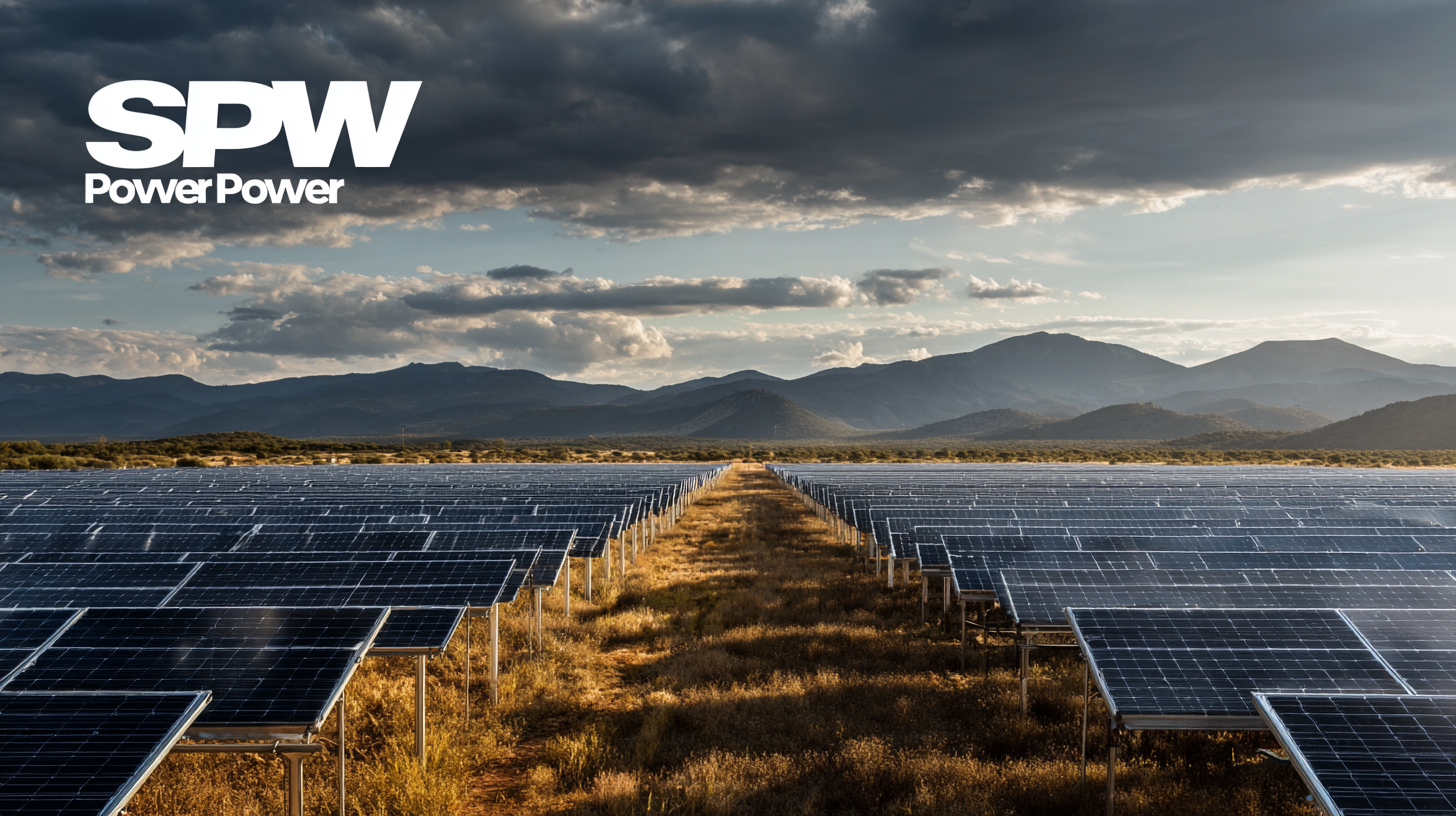Global Solar Power Trends to Watch in 2025: The Rise of the Best Solar Innovations
As we look toward 2025, the solar power industry stands at the cusp of transformative change, driven by groundbreaking innovations and a growing global demand for sustainable energy solutions. In an era marked by climate urgency and technological advancement, understanding the key trends shaping solar power is vital for both industry stakeholders and consumers alike. This blog will explore the anticipated market developments, emphasizing cutting-edge technologies that promise to enhance efficiency, reduce costs, and broaden accessibility. Moreover, we will provide insightful data and practical tips for navigating this rapidly evolving landscape. By highlighting the best solar innovations on the horizon, we aim to illuminate the path forward for a greener, more sustainable future powered by solar energy.

The Role of Chinese Solar Manufacturers in Global Energy Transition
The role of Chinese solar manufacturers in the global energy transition cannot be overstated as we look toward 2025. With China being home to some of the largest solar panel producers, such as LONGi Green Energy and Trina Solar, the country accounts for approximately 70% of the global solar supply chain. According to the International Energy Agency (IEA), China alone is projected to increase its solar capacity by more than 200 GW by 2025, playing a pivotal role in the world’s goal to achieve a net-zero carbon emissions target.
Additionally, innovations emerging from China’s vast solar industry exhibit significant potential for improving efficiency and reducing costs. For instance, the adoption of bifacial solar panels has been reported to increase energy generation by up to 30%, providing substantial returns on investment for solar projects. As these innovations penetrate the market, they could accelerate the global transition towards renewable energy, aligning with the United Nations' Sustainable Development Goals and fostering a more sustainable energy landscape on a global scale.
Innovative Solar Technologies Emerging from China’s Manufacturing Hub
As the world increasingly shifts towards renewable energy, China's manufacturing hub continues to emerge as a leader in innovative solar technologies. In 2025, we can expect to see groundbreaking developments originating from this region that are not just enhancing efficiency but also driving down costs. These advancements, including next-generation photovoltaic cells and improved energy storage systems, are setting the stage for a greener future.
One of the most exciting trends is the rise of bifacial solar panels, which capture sunlight on both sides, maximizing energy generation. Paired with innovative manufacturing processes, these panels are becoming more affordable and accessible. Additionally, advances in smart solar technology, such as integrated IoT solutions, are providing users with enhanced energy management capabilities, allowing for real-time monitoring and optimization of solar power usage. As these technologies continue to evolve, the impact of China's innovations on the global solar market will be profound, making solar energy an even more attractive option for consumers and businesses alike.
Global Solar Power Innovations in 2025
This bar chart represents the projected growth in different solar technologies by 2025 based on data trends and innovations emerging from China's manufacturing sector.
Exporting Solar Solutions: China's Impact on Global Renewable Energy Markets
The global solar power landscape is evolving rapidly, with China emerging as a dominant player in renewable energy markets. As the world's largest producer of solar panels, China not only leads in manufacturing but also plays a pivotal role in exporting solar solutions worldwide. This influence is reshaping energy consumption patterns in various countries, as nations look to China for affordable, innovative, and efficient solar technologies.
China’s commitment to renewable energy is evident in its ambitious goals and investments. By 2025, we can expect to see even more advanced solar innovations exported globally, from high-efficiency solar cells to integrated solar technologies that promise to enhance energy output. Countries seeking to transition to greener energy sources are increasingly turning to Chinese products, recognizing their potential to significantly reduce costs and accelerate the adoption of solar power.
Moreover, China's strategic partnerships and investments in solar projects abroad are strengthening its position in global markets. By exporting not only technology but also knowledge and expertise, China is facilitating the growth of renewable energy infrastructure in emerging markets, making solar power more accessible than ever. As this trend continues, it is clear that China will play a crucial role in shaping the future of global renewable energy.

Future Trends: How Chinese Innovations are Shaping Solar Power in 2025
As we look ahead to 2025, the landscape of solar power is set to be significantly influenced by innovative advancements emerging from China. The country has rapidly established itself as a global leader in solar technology, driving both efficiency and affordability in photovoltaic systems. Key innovations originating from Chinese firms are not only enhancing solar panel performance but also reducing production costs, thus making solar energy more accessible for a wider audience.

One noteworthy trend is the development of bifacial solar panels, which capture sunlight from both sides, effectively increasing energy yield. This technology, along with improvements in energy storage solutions, is redefining solar installations by maximizing output and reliability. Additionally, the integration of artificial intelligence and smart grid technology is streamlining operations, allowing for real-time data analysis and management, which ultimately leads to optimized energy consumption and distribution. With these advancements, China's influence will continue to propel the solar power sector into a new era of sustainability and efficiency by 2025.
Sustainability and Efficiency: The Driving Forces Behind China's Solar Exports
China continues to dominate the global solar power market, driven by the dual forces of sustainability and efficiency. As of 2023, China's solar module exports accounted for over 70% of the global total, showcasing the nation’s commitment to affordable, high-quality solar solutions. A report by the International Energy Agency (IEA) indicates that China installed nearly 59 gigawatts (GW) of solar capacity in 2022 alone, cementing its position as a leading player in renewable energy. The expansion is largely attributed to the government's ambitious policies aimed at reducing carbon emissions and promoting green technologies.
The rise in solar exports is significantly fueled by innovations in solar technology, such as bifacial solar panels and advanced energy storage systems. According to an analysis by BloombergNEF, the efficiency of solar panels has improved dramatically, with leading manufacturers achieving conversion rates above 22%. This emphasis on cutting-edge technology not only enhances performance but also decreases the levelized cost of electricity (LCOE), making solar power more accessible. As these trends continue, China is likely to strengthen its leadership in solar energy, contributing to a more sustainable global future.
Global Solar Power Trends to Watch in 2025: The Rise of the Best Solar Innovations
| Trend | Description | Impact (Score: 1-10) | Region Leading |
|---|---|---|---|
| Bifacial Solar Panels | Increased efficiency by capturing sunlight from both sides. | 8 | Asia-Pacific |
| Floating Solar Farms | Utilizing bodies of water to install solar panels, reducing land use. | 7 | North America |
| Solar Tracking Systems | Maximizing energy capture by aligning panels with the sun. | 9 | Europe |
| Energy Storage Solutions | Innovations in batteries to store solar power for later use. | 10 | Asia-Pacific |
| Recycling of Solar Panels | Sustainable practices to recycle and reduce waste from solar technology. | 8 | Worldwide |

